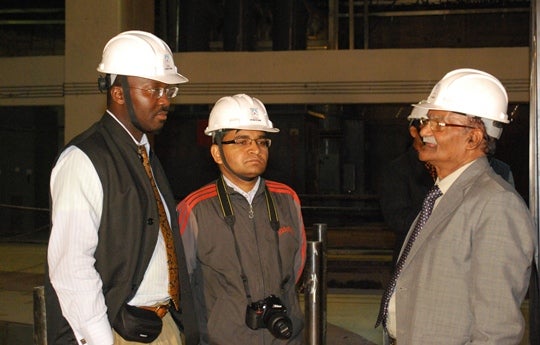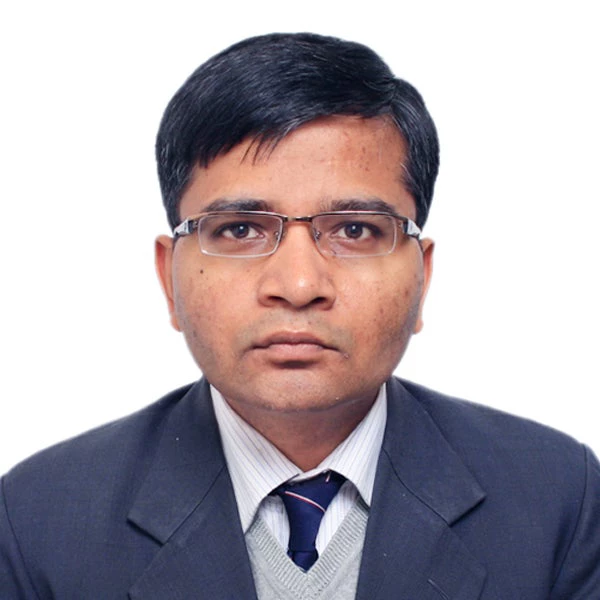
The two Task Team Leaders, (from left) Kwawu Gaba and Rohit Mittal,
with the Chairman-cum-Managing Director of SJVNL, Mr R P Singh
When a small Bank team, of which one of us was a member, first visited the project site in December 2004, it wasn’t exactly a picture-perfect scenario. We were deep in the Himalayas and it was the middle of winter. Barren mountainsides rose up all around us, the icy Satluj river flowed steadily down, and the wind was howling.
How could we possibly build a hydropower project in this forbidding terrain in a few years’ time? Stories of past challenges from the earlier Nathpa Jhakri project - about 15 kilometers upstream - came flooding into everyone’s mind. But failure was not an option. The Bank was reengaging in hydropower in India after a gap of more than 10 years, and a great deal was riding on each one of us.
Now, more than a decade later, we find ourselves standing before the almost-fully built Rampur powerhouse. As a wonderful coincidence, both of us happen to be present as the first of the project’s six units roars into operation and is synchronized with India’s northern power grid.
Looking back, we are filled with a huge sense of gratitude to all those who made it happen. For our decade-long journey has not been easy.
In June 2009, barely a year into construction, an enormous rock collapse stopped our progress dead in its tracks. Huge pieces of rock and torrents of water came flooding into the underground tunnel that was being excavated to carry water to the turbines. The Himalayas are geologically young mountains, and one never knows what to expect when digging deep within their underbelly! The collapse opened up a Pandora’s box of troubles that were sure to set us back by 2-4 years at least …or so we thought.
But we had to power through. The project’s developers - SJVN Limited -gathered all their resources and realigned the tunnel. With the Bank’s help, they also mobilized a panel of international experts to guide them through the complex process of carving out a new channel.
Then, in early 2010, while we were still grappling with the aftermath of the rock collapse, we were struck by another blow. The slope above the power house collapsed, and with it went the southern flood protection wall. We hoped this would be the last of our problems.
But calamity seldom strikes just once. This dreadful occurrence was soon followed by a worker’s strike at the construction site, and few months later concerns arose about the safety of the villagers in project’s vicinity, and about the disposal of debris.
It was a difficult period. The task team visited the site every two months to see that the pace of construction was maintained. And we matured together, learning from the greatest teacher of all – adversity.
Personally, the experience has been enriching. While one of us has been associated with the project from the very beginning, and the other joined soon after construction began, we have both learned to examine matters through a variety of lenses – not just from the engineering perspective but also from the social and environmental angles which can so often make or mar a project.
Good leadership, our experience demonstrates, is critical. While strong systems can help, it is ultimately the person in the lead who makes the vital difference. And, in this we were fortunate.
Relationships are very essential. In SJVNL, Kranti Gupta, the project director at the site, and H.B. Sahay in the corporate office, have been with us through thick and thin, always displaying a pragmatic and positive attitude in overcoming problems. Mr. Gupta, a very hands-on person, constantly motivated and boosted his team, enabling them to bounce back with renewed focus in spite of the many setbacks they suffered. He also followed an open door policy and was always available to the local people, maintaining a good rapport with the community, a crucial element of our project’s ultimate success.
We have also gained huge respect for the engineers and staff of the SJVNL who took enormous pride in their work. They were present at those forbidding sites day in and day out, often under very difficult circumstances. From them we have learnt to maintain our tranquility and composure whatever may come our way.
And finally, as the Bank’s decade-long journey with this project approaches a successful close, we can undoubtedly say “there is a light at the end of the tunnel”.
Read More:
A Hydropower Project brings Development to Himalayan Villages
In the Belly of the Himalayas
Rampur Hydropower Project
Rampur Hydropower Project: Benefits for All



Join the Conversation